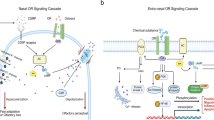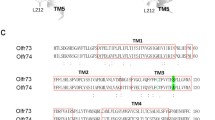Abstract
We modeled the firing rate of populations of olfactory receptor neurons (ORNs) responding to an odorant at different concentrations. Two cases were considered: a population of ORNs that all express the same olfactory receptor (OR), and a population that expresses many different ORs. To take into account ORN variability, we replaced single parameter values in a biophysical ORN model with values drawn from statistical distributions, chosen to correspond to experimental data. For ORNs expressing the same OR, we found that the distributions of firing frequencies are Gaussian at all concentrations, with larger mean and standard deviation at higher concentrations. For a population expressing different ORs, the distribution of firing frequencies can be described as the superposition of a Gaussian distribution and a lognormal distribution. Distributions of maximum value and dynamic range of spiking frequencies in the simulated ORN population were similar to experimental results.













Similar content being viewed by others
Explore related subjects
Discover the latest articles and news from researchers in related subjects, suggested using machine learning.References
Abraham, N. M., Spors, H., Carleton, A., Margrie, T. W., Kuner, T., & Schaefer, A. T. (2004). Maintaining accuracy at the expense of speed: stimulus similarity defines odor discrimination time in mice. Neuron, 44, 865–876.
Bargmann, C. I. (2006). Comparative chemosensation from receptors to ecology. Nature, 444, 295–301. doi:10.1038/nature05402.
Bazhenov, M., Stopfer, M., Rabinovich, M., Abarbanel, H. D. J., Sejnowski, T. J., & Laurent, G. (2001). Model of cellular and network mechanisms for odor-evoked temporal patterning in the locust antennal lobe. Neuron, 30, 569–581. doi:10.1016/S0896-6273(01)00286-0.
Cleland, T. A., & Linster, C. (1999). Concentration tuning mediated by spare receptor capacity in olfactory sensory neurons: a theoretical study. Neural Computation, 11, 1673–1690. doi:10.1162/089976699300016188.
Cleland, T. A., & Linster, C. (2005). Computation in the olfactory system. Chemical Senses, 30, 801–813. doi:10.1093/chemse/bji072.
Christensen, T. A., D’Alessandro, G., Lega, J., & Hildebrand, J. G. (2001). Morphometric modeling of olfactory circuits in the insect antennal lobe: I. Simulations of spiking local interneurons. BioSystems, 61, 143–153.
Dougherty, D. P., Wright, G. A., & Yew, A. C. (2005). Computational model of the cAMP-mediated sensory response and calcium-dependent adaptation in vertebrate olfactory receptor neurons. Proceedings of the National Academy of Sciences of the United States of America, 102, 10415–10420. doi:10.1073/pnas.0504099102.
Duchamp, A., & Sicard, G. (1984). Influence of stimulus intensity on odour discrimination by olfactory bulb neurons as compared with receptor cells. Chemical Senses, 8, 355–366. doi:10.1093/chemse/8.4.355.
Duchamp, A., Revial, M. F., Holley, A., & MacLeod, P. (1974). Odor discrimination by frog olfactory receptors. Chemical Senses, 1, 213–233. doi:10.1093/chemse/1.2.213.
Duchamp-Viret, P., Duchamp, A., & Chaput, M. A. (2003). Single olfactory receptor neurons simultaneously integrate the components of an odour mixture. The European Journal of Neuroscience, 18, 2690–2696. doi:10.1111/j.1460-9568.2003.03001.x.
Friedrich, R. W., & Laurent, G. (2004). Dynamics of olfactory bulb input and output activity during odor stimulation in zebrafish. Journal of Neurophysiology, 91, 2658–2669. doi:10.1152/jn.01143.2003.
Grosmaître, X., Vassalli, A., Mombaerts, P., Shepherd, G. M., & Ma, M. (2006). Odorant responses of olfactory sensory neurons expressing the odorant receptor MOR23: a patch clamp analysis in gene-targeted mice. Proceedings of the National Academy of Sciences of the United States of America, 103, 1970–1975. doi:10.1073/pnas.0508491103.
Hahn, I., Scherer, P. W., & Mozell, M. M. (1994). A mass transport model of olfaction. Journal of Theoretical Biology, 167, 115–128. doi:10.1006/jtbi.1994.1057.
Hildebrand, J. G., & Shepherd, G. M. (1997). Mechanisms of olfactory discrimination: converging evidence for common principles across phyla. Annual Review of Neuroscience, 20, 595–631. doi:10.1146/annurev.neuro.20.1.595.
Imanaka, Y., & Takeuchi, H. (2001). Spiking properties of olfactory receptor cells in the slice preparation. Chemical Senses, 26, 1023–1027.
Johnson, B. A., & Leon, M. (2007). Chemotopic odorant coding in a mammalian olfactory system. The Journal of Comparative Neurology, 503, 1–34. doi:10.1002/cne.21396.
Kaissling, K.-E. (2001). Olfactory perireceptor and receptor events in moths: a kinetic model. Chemical Senses, 26, 125–150. doi:10.1093/chemse/26.2.125.
Kostal, L., Lánský, P., & Rospars, J. P. (2008). Efficient olfactory coding in the pheromone receptor neuron of a moth. PLoS Computational Biology, 4(4), e1000053. doi:10.1371/journal.pcbi.1000053.
Laurent, G. (2002). Olfactory network dynamics and the coding of multidimensional signals. Nature Reviews. Neuroscience, 3, 884–895. doi:10.1038/nrn964.
Lewcock, J. W., & Reed, R. R. (2004). A feedback mechanism regulates monoallelic odorant receptor expression. Proceedings of the National Academy of Sciences of the United States of America, 101, 1069–1074. doi:10.1073/pnas.0307986100.
Martinez, D. (2005). Oscillatory synchronization requires precise and balanced feedback inhibition in a model of the insect antennal lobe. Neural Computation, 17, 2548–2570.
Mombaerts, P. (2004). Odorant receptor gene choice in olfactory sensory neurons: the one receptor - one neuron hypothesis revisited. Current Opinion in Neurobiology, 14, 31–36. doi:10.1016/j.conb.2004.01.014.
Mombaerts, P., Wang, F., Dulac, C., Chao, S. K., Nemes, A., Mendelsohn, M., et al. (1996). Visualizing an olfactory sensory map. Cell, 87, 675–686. doi:10.1016/S0092-8674(00)81387-2.
Pongracz, F., Firestein, S., & Shepherd, G. M. (1991). Electrotonic structure of olfactory sensory neurons analyzed by intracellular and whole cell patch techniques. Journal of Neurophysiology, 65, 747–758.
Rospars, J.-P., & Fort, J. C. (1994). Coding of odor quality: roles of convergence and inhibition. Network. Computation in Neural Systems, 5, 121–145. doi:10.1088/0954-898X/5/2/001.
Rospars, J.-P., & Lánský, P. (2004). Stochastic pulse stimulation in chemoreceptors and its properties. Mathematical Biosciences, 188, 133–145. doi:10.1016/j.mbs.2003.08.001.
Rospars, J.-P., Lánský, P., Tuckwell, H. C., & Vermeulen, A. (1996). Coding of odor intensity in a steady-state deterministic model of an olfactory receptor neuron. Journal of Computational Neuroscience, 3, 51–72. doi:10.1007/BF00158337.
Rospars, J.-P., Lánský, P., Duchamp, A., & Duchamp-Viret, P. (2003). Relation between stimulus and response in frog olfactory receptor neurons in vivo. The European Journal of Neuroscience, 18, 1135–1154. doi:10.1046/j.1460-9568.2003.02766.x.
Rospars, J.-P., Lucas, P., & Coppey, M. (2007). Modelling the early steps of transduction in insect olfactory receptor neurons. Bio Systems, 89, 101–109. doi:10.1016/j.biosystems.2006.05.015.
Rospars, J.-P., Lánský, P., Duchamp, A., & Duchamp-Viret, P. (2008). Competitive and noncompetitive odorant interactions in the early neural coding of odorant mixtures. The Journal of Neuroscience, 28, 2659–2666. doi:10.1523/JNEUROSCI.4670-07.2008.
Saltelli, A. (2004). Sensitivity analysis in practice: a guide to assessing scientific models. Wiley.
Schaefer, A. T., & Margrie, T. W. (2007). Spatiotemporal representations in the olfactory system. Trends in Neurosciences, 30, 92–100. doi:10.1016/j.tins.2007.01.001.
Serizawa, S., Miyamichi, K., Nakatani, H., Suzuki, M., Saito, M., Yoshihara, Y., et al. (2003). Negative feedback regulation ensures the one receptor-one olfactory neuron rule in mouse. Science, 302, 2088–2094. doi:10.1126/science.1089122.
Shykind, B. M. (2005). Regulation of odorant receptors: one allele at a time. Human Molecular Genetics, 14, R33–R39. doi:10.1093/hmg/ddi105.
Simoes de Souza, F. M., & Antunes, G. (2007). Biophysics of olfaction. Reports on Progress in Physics, 70, 451–491. doi:10.1088/0034-4885/70/3/R04.
Strausfeld, N. J., & Hildebrand, J. G. (1999). Olfactory systems: common design, uncommon origins? Current Opinion in Neurobiology, 9, 634–639. doi:10.1016/S0959-4388(99)00019-7.
Suzuki, N., Takahata, M., & Sato, K. (2002). Oscillatory current responses of olfactory receptor neurons to odorants and computer simulation based on a cyclic AMP transduction model. Chemical Senses, 27, 789–801. doi:10.1093/chemse/27.9.789.
Trotier, D. (1994). Intensity coding in olfactory receptor cells. Seminars in Cell Biology, 5, 47–54.
Vermeulen, A., & Rospars, J.-P. (1998). Dendritic integration in olfactory sensory neurons: a steady-state analysis of how the neuron structure and neuron environment influence the coding of odor intensity. Journal of Computational Neuroscience, 5, 243–266. doi:10.1023/A:1008826827728.
Wise, P. M., Miyazawa, T., Gallagher, M., & Preti, G. (2007). Human odor detection of homologous carboxylic acids and their binary mixtures. Chemical Senses, 32, 475–482. doi:10.1093/chemse/bjm016.
Yang, G. C., Scherer, P. W., & Mozell, M. M. (2007). Modeling inspiratory and expiratory steady-state velocity fields in the Sprague-Dawley rat nasal cavity. Chemical Senses, 32, 215–223. doi:10.1093/chemse/bjl047.
Zufall, F., & Leinders-Zufall, T. (2000). The cellular and molecular basis of odor adaptation. Chemical Senses, 25, 473–481. doi:10.1093/chemse/25.4.473.
Acknowledgements
This work was supported by the European Network of Excellence “General Olfaction and Sensing Projects on a European Level” (GOSPEL) and by the European grant FP7 Bio-ICT convergence No. 216916 “Biologically inspired computation for chemical sensing” (Neurochem) to M.S., A.L., J.H.-K. and J.-P.R., and by the French-British grant ANR-BBSRC Sysbio 2007 “Pherosys” to J.-P.R. We thank Petr Lánský and two anonymous referees for helpful suggestions.
Author information
Authors and Affiliations
Corresponding author
Additional information
Action Editor: C. Linster
Rights and permissions
About this article
Cite this article
Sandström, M., Lansner, A., Hellgren-Kotaleski, J. et al. Modeling the response of a population of olfactory receptor neurons to an odorant. J Comput Neurosci 27, 337–355 (2009). https://doi.org/10.1007/s10827-009-0147-5
Received:
Revised:
Accepted:
Published:
Issue Date:
DOI: https://doi.org/10.1007/s10827-009-0147-5




